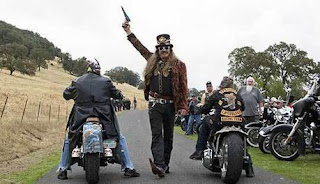 The Hells Angels Motorcycle Club (HAMC) is a worldwide one-percenter motorcycle club whose members typically ride Harley-Davidson motorcycles and is considered an organized crime syndicate by the U.S.
The Hells Angels Motorcycle Club (HAMC) is a worldwide one-percenter motorcycle club whose members typically ride Harley-Davidson motorcycles and is considered an organized crime syndicate by the U.S.
Department of Justice In the United States and Canada, the Hells Angels are incorporated as the Hells Angels Motorcycle Corporation.
Common nicknames for the club are the "H.A.", "Red & White", and "81" (H and A being the eighth and first letters of the alphabet).
The Hells Angels were originally started by Scottish-American war immigrants, the Bishop family in Fontana, California[8] followed by an amalgamation of former members from different motorcycle clubs, such as the Pissed Off Bastards of Bloomington.
[9][10] The Hells Angels' website denies the suggestion that any misfit or malcontent troops are connected with the motorcycle club.
The website also notes that the name was suggested by Arvid Olsen, an associate of the founders, who had served in the Flying Tigers' "Hells Angels" squadron in China during World War II. The name "Hells Angels" was inspired by the typical naming of American squadrons, or other fighting groups, with a fierce, death-defying title in both World War I and World War II, e.g., the Flying Tigers (American Volunteer Group) in Burma and China fielded three squadrons of P-40s and the third Squadron was called "Hell's Angels".
In 1930, the Howard Hughes film Hell's Angels displayed extraordinary and dangerous feats of aviation, and it is believed that the World War II groups who used that name based it on the film.Some of the early history of the HAMC is not clear, and accounts differ.
According to Ralph 'Sonny' Barger, founder of the Oakland chapter, early chapters of the club were founded in San Francisco, Gardena, Fontana, as well as his chapter in Oakland, and other places independently of one another, with the members usually being unaware that there were other Hells Angels clubs.
Other sources claim that the Hells Angels in San Francisco were originally organized in 1953 by Rocky Graves, a Hells Angel member from San Bernardino ("Berdoo") implying that the "Frisco" Hells Angels were very much aware of their forebears.
The "Frisco" Hells Angels were reorganized in 1955 with thirteen charter members,The Oakland chapter, at the time headed by Barger used a larger version of the "Death's Head" patch nicknamed the "Barger Larger" which was first used in 1959.
The Hells Angels are often depicted in a similarly mythical fashion as other modern-day legends like the James-Younger Gang; free-spirited, iconic, bound by brotherhood and loyalty.
At other times, such as in the 1966 Roger Corman film The Wild Angels where they are depicted as violent and nihilistic, they are portrayed as a violent criminal gang and a scourge on society.
The club became prominent within, and established its initial notoriety as part of, the 1960s counterculture movement in San Francisco's Haight-Ashbury scene, London, in England, and elsewhere where it played a part at many of the movement's seminal events.
 Original members were directly connected to many of the counterculture's primary leaders, such as Ken Kesey and the Merry Pranksters, Allen Ginsberg, Jerry Garcia and The Grateful Dead, Timothy Leary, The Beatles, The Rolling Stones, Mick Farren and Tom Wolfe.
Original members were directly connected to many of the counterculture's primary leaders, such as Ken Kesey and the Merry Pranksters, Allen Ginsberg, Jerry Garcia and The Grateful Dead, Timothy Leary, The Beatles, The Rolling Stones, Mick Farren and Tom Wolfe.
The club launched the career of "Gonzo" journalist Hunter S. Thompson.Criminologist Karen Katz said in 2011 that the Hells Angels were the center of a moral panic in Canada involving the media, politicians, law enforcement and the public that sensationalized the importance of isolated criminal acts....